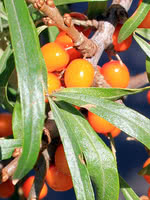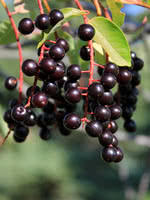Mon-Fri 9am - 5pm Mountain time
Sea Buckthorn (Seaberry) vs Western Chokecherry
Hippophae rhamnoides l.
Prunus virginiana var. demissa
Sea Buckthorn, aka Seaberry, is a nitrogen fixing shrub that produces attractive berries high in vitamin C.
While we can't confirm claims that the berries are effective in treating various ailments, many people believe consuming the berries helps with arthritis, infections, and asthma, among other things.
Sea Buckthorn plants have attractive pale silvery-green leaves, dense branches, and large thorns, people like to grow in ornamental hedges or as a first row in a shelterbelt.
Note: these plants typically reach maturity and make their sex easily known (females producing fruit) in their 3rd or 4th year of growth. Our seedlings are too young to identify their sex.
Western Chokecherry is a shrub or small tree commonly used for farmstead and field windbreaks.
It produces white flowers in the spring and edible dark purple fruit that matures between September and October. Its cherries are great for making for making jams, jellies or wine, but are not very palatable for raw eating.
Sea Buckthorn (Seaberry) Quick Facts
Western Chokecherry Quick Facts
Toxicity: toxic to horses, cattle, etc.)
In row spacing: 0.9 - 1.2 m (3 - 4 ft)

